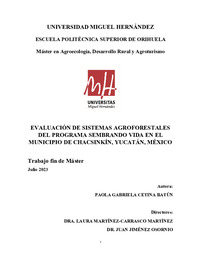Por favor, use este identificador para citar o enlazar este ítem:
https://hdl.handle.net/11000/30410Registro completo de metadatos
| Campo DC | Valor | Lengua/Idioma |
|---|---|---|
| dc.contributor.advisor | Martínez-Carrasco, Laura | - |
| dc.contributor.advisor | Jiménez Osorno, Juan | - |
| dc.contributor.author | Cetina Batún, Paola G. | - |
| dc.contributor.other | Departamentos de la UMH::Economía Agroambiental,Ing. Cartográfica y Expresión Gráfica en la Ingeniería | es_ES |
| dc.date.accessioned | 2023-12-14T13:26:15Z | - |
| dc.date.available | 2023-12-14T13:26:15Z | - |
| dc.date.created | 2023-07 | - |
| dc.identifier.uri | https://hdl.handle.net/11000/30410 | - |
| dc.description.abstract | En 2019, el Gobierno Federal de México implementó el Programa Sembrando Vida con el objetivo de incrementar la producción de alimentos y fomentar el desarrollo rural, a través del establecimiento de sistemas agroforestales. Se requiere evaluar los sistemas agroforestales implementados por el programa de manera holística para determinar las implicaciones de las decisiones realizadas y el alcance de los objetivos. El objetivo de este trabajo fue evaluar los sistemas agroforestales del Programa Sembrando Vida en la comunidad de Chacsinkín, Yucatán, desde un enfoque socioecológico. Se aplicaron cuestionarios socioeconómicos y productivos y se organizaron grupos focales de discusión, los datos se analizaron empleando el Marco de Sistemas Socioecológicos. La comunidad de Chacsinkín interactúa con sus recursos naturales a través del manejo de dos sistemas agroforestales tradicionales, huertos familiares y milpas, así como los sistemas agroforestales del programa Sembrando Vida. Estos sistemas están determinados por las características socioeconómicas de los productores y la organización comunitaria del uso de los recursos naturales, y donde el programa ha generado cambios. El Programa Sembrando Vida debe considerar las características que determinan el manejo de los sistemas agroforestales para incidir adecuadamente y lograr con éxito los objetivos planteados | es_ES |
| dc.description.abstract | In 2019, the Federal Government of Mexico implemented the Sembrando Vida Program with the objective of increasing food production and promoting rural development through the establishment of agroforestry systems. It is necessary to evaluate the agroforestry systems implemented by the program holistically to determine the implications of the decisions made and the achievement of the objectives. The aim of this work was to evaluate the agroforestry systems of the Sembrando Vida Program in the community of Chacsinkin, Yucatan from a socioecological approach. Socioeconomic and productive questionnaires and focus group discussions were conducted, and the data were analyzed using the Socioecological Systems Framework. The community of Chacsinkín interacts with its natural resources through the management of two traditional agroforestry systems, home gardens and milpas, as well as the agroforestry systems of the Sembrando Vida program. These systems are determined by the socioeconomic characteristics of the producers and the community organization to use natural resources, and where the program has generated changes. The Sembrando Vida Program must consider the characteristics that determine the management of agroforestry systems in order to adequately influence and successfully achieve the proposed objectives | es_ES |
| dc.format | application/pdf | es_ES |
| dc.format.extent | 47 | es_ES |
| dc.language.iso | spa | es_ES |
| dc.publisher | Universidad Miguel Hernández | es_ES |
| dc.rights | info:eu-repo/semantics/openAccess | es_ES |
| dc.rights.uri | http://creativecommons.org/licenses/by-nc-nd/4.0/ | * |
| dc.subject | Agroecosistemas | es_ES |
| dc.subject | Sistemas socioecológicos | es_ES |
| dc.subject.other | CDU::6 - Ciencias aplicadas::63 - Agricultura. Silvicultura. Zootecnia. Caza. Pesca::631 - Agricultura. Agronomía. Maquinaria agrícola. Suelos. Edafología agrícola | es_ES |
| dc.title | Evaluación de sistemas agroforestales del programa Sembrando Vida en el municipio de Chacsinkín, Yucatán, México | es_ES |
| dc.type | info:eu-repo/semantics/masterThesis | es_ES |

Ver/Abrir:
TFM Cetina Batún, Paola Gabriela.pdf
2,89 MB
Adobe PDF
Compartir:
 La licencia se describe como: Atribución-NonComercial-NoDerivada 4.0 Internacional.
La licencia se describe como: Atribución-NonComercial-NoDerivada 4.0 Internacional.
.png)